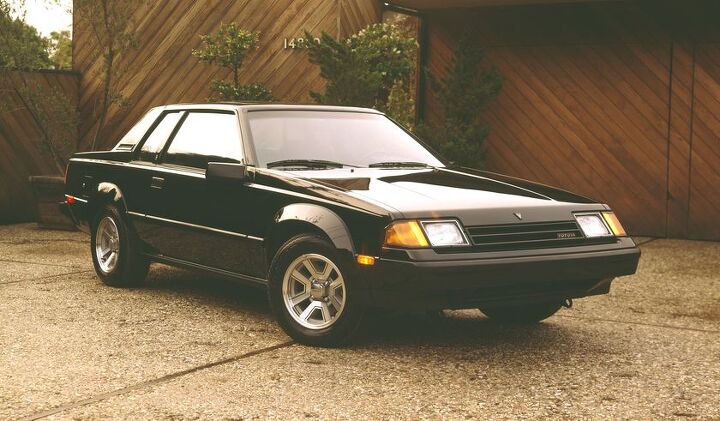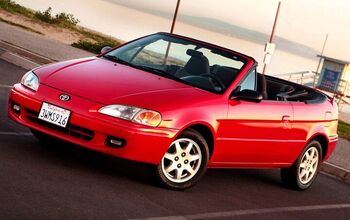Rare Rides: The 1983 Toyota Celica, a Sporting Cabriolet

Today we feature the first Toyota Celica presented in the Rare Rides series. It’s beige, very Eighties, and was converted to a convertible after it arrived in the United States. And the lights flip up!
Toyota’s Celica was born late in 1970, as a pony-car competitor to the successful Ford Mustang. As the first-gen model gave way to a second for the 1978 model year, Celica grew in all dimensions. The same occurred again for its third A60 generation, which entered production in summer 1981 for the ’82 model year.
The formula for the new Celica was much the same as before: Engine at the front, driven wheels at the rear, and a stylish body in the middle. While the original Celica was a bit curvaceous, the model’s second and third albums upped the square factor considerably. It’d be fair to award the A60 Celica with the Most Square Celica Ever title. Underneath the new body was a variety of engines depending on trim and market. The smallest power on offer came from a 1.6-liter inline-four (the 2T-B), while the largest engine available was the 2.4-liter 22R shared with the Toyota Pickup. All engines were inline-four in arrangement and paired to a four-speed automatic or five-speed manual. Three different versions of the five-speed were offered during the A60’s life.
The Celica received a few updates in North America, notably fuel injection in cars built after August 1982, where the 22R became 22R-E. To utilize the revamped 22R-E, Toyota introduced the GT-S model in North America. This more powerful version was meant to help claw back some of the sports-car appeal the Celica lost as it got bigger and gained weight over the years. There was a global facelift for the 1984 model year, where concealed pop-up headlamps replaced the flip-up ones, along with a more modern grille treatment featuring a flush section, a new lower front spoiler, and different tail lamps at the rear.
The third generation continued the more formal notchback coupe and faster-looking liftback body styles, but in 1983 added a third option: A cabriolet. Built only for the American market, Toyota contracted with ASC to chop the top off 200 Celicas in 1983. Sales were hot enough for Toyota to order more and continued to build facelifted convertibles in 1984 and 1985 (facelifted version shown above). All 1983 convertibles were ST trim, while ’84-’85 convertibles were the new and spicy GT-S.
Celica’s A60 generation remained in production through 1985 and was replaced with the more modern (and front-drive) T160 for the 1986 model year. Toyota softened the sharp edges and modernized the affordable sports car’s powertrain. But they kept the pop-up lamps. ASC kept on converting Celicas into convertibles during the T160 generation, with the added ask of modification of right-hand-drive examples for the Japanese market.
Today’s Rare Ride is one of 200 initial year, pre-facelift carbureted Celica convertibles. With 117,000 miles, it’s in excellent condition. The seller assures the value on these is skyrocketing, so strike while the iron’s hot. Would make a great car for driving, or for sitting in while not driving. Yours for $8,900.
[Images: Toyota]

Interested in lots of cars and their various historical contexts. Started writing articles for TTAC in late 2016, when my first posts were QOTDs. From there I started a few new series like Rare Rides, Buy/Drive/Burn, Abandoned History, and most recently Rare Rides Icons. Operating from a home base in Cincinnati, Ohio, a relative auto journalist dead zone. Many of my articles are prompted by something I'll see on social media that sparks my interest and causes me to research. Finding articles and information from the early days of the internet and beyond that covers the little details lost to time: trim packages, color and wheel choices, interior fabrics. Beyond those, I'm fascinated by automotive industry experiments, both failures and successes. Lately I've taken an interest in AI, and generating "what if" type images for car models long dead. Reincarnating a modern Toyota Paseo, Lincoln Mark IX, or Isuzu Trooper through a text prompt is fun. Fun to post them on Twitter too, and watch people overreact. To that end, the social media I use most is Twitter, @CoreyLewis86. I also contribute pieces for Forbes Wheels and Forbes Home.
More by Corey Lewis
Latest Car Reviews
Read moreLatest Product Reviews
Read moreRecent Comments
- Theflyersfan The wheel and tire combo is tragic and the "M Stripe" has to go, but overall, this one is a keeper. Provided the mileage isn't 300,000 and the service records don't read like a horror novel, this could be one of the last (almost) unmodified E34s out there that isn't rotting in a barn. I can see this ad being taken down quickly due to someone taking the chance. Recently had some good finds here. Which means Monday, we'll see a 1999 Honda Civic with falling off body mods from Pep Boys, a rusted fart can, Honda Rot with bad paint, 400,000 miles, and a biohazard interior, all for the unrealistic price of $10,000.
- Theflyersfan Expect a press report about an expansion of VW's Mexican plant any day now. I'm all for worker's rights to get the best (and fair) wages and benefits possible, but didn't VW, and for that matter many of the Asian and European carmaker plants in the south, already have as good of, if not better wages already? This can drive a wedge in those plants and this might be a case of be careful what you wish for.
- Jkross22 When I think about products that I buy that are of the highest quality or are of great value, I have no idea if they are made as a whole or in parts by unionized employees. As a customer, that's really all I care about. When I think about services I receive from unionized and non-unionized employees, it varies from C- to F levels of service. Will unionizing make the cars better or worse?
- Namesakeone I think it's the age old conundrum: Every company (or industry) wants every other one to pay its workers well; well-paid workers make great customers. But nobody wants to pay their own workers well; that would eat into profits. So instead of what Henry Ford (the first) did over a century ago, we will have a lot of companies copying Nike in the 1980s: third-world employees (with a few highly-paid celebrity athlete endorsers) selling overpriced products to upper-middle-class Americans (with a few urban street youths willing to literally kill for that product), until there are no more upper-middle-class Americans left.
- ToolGuy I was challenged by Tim's incisive opinion, but thankfully Jeff's multiple vanilla truisms have set me straight. Or something. 😉




































Comments
Join the conversation
I had a ~1984 Celica with the 22R-E engine around 1998. I bought the car for $100; stripped out the interior, glass, and even some of the body; installed a roll bar and some winter tires and some buddies and I drove it as a shared ice racer for several years. At one point the car sat uncovered in a farmer's field for 2 years - we showed up with a fresh battery and gas, and it fired on the second crank. The brakes unseized after we dragged the car behind a truck for a few minutes; we used the car for another season. The car had been nicknamed "Slowleaka" because it was slow, and it leaked every fluid. I never replaced any fluid, only kept topping up. At the end the car was sold for $150 after 4 or 5 years of abuse. Toughest car I ever owned.
Curious Cars has both versions of goats, birds and cats: GTO, Thunderbird and Cougar! Always a great show and so many of his cars were like the ones I sold in the late 1970s. The best example I have here at the high desert ranch is my 1984 Buick Le Sabre Limited coupe with 64,212 miles in mint condition.